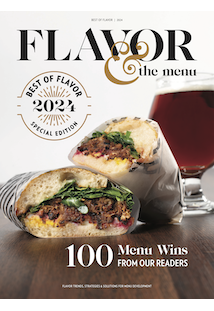
Veteran globe-trotters know that they can travel to the ends of the Earth and be assured that onions will be at the heart of local cuisines almost anywhere they go. Few ingredients cross cultures as readily as the onion, deemed essential in the flavor builds of countless dishes. Food historians peg its earliest cultivation 7,000 years ago and have not been able to home in on a geographic origin, with ancient references found in both east and west Asia. Although European explorers brought onions to the Americas, they discovered close relatives of the bulb plant already integrated into native cookery. Even where not indigenous, onions long ago took root as a gastronomic mainstay .
Today, as chefs bring global flavors into focus through classic preparations, niche concepts, fusions, mash-ups, cross-overs and other menu mixes, onions are a fundamental ingredient in the kitchen. “I believe onions are the most versatile vegetable in the world,” says Chef Steven Agosta, Executive Chef, Morongo Casino Resort & Spa. “They are literally used in every type of cuisine, ranging from European to Asian and from African to Latin American.” They are used to build flavors in stocks, soups, sauces and salsas, he cites. “Onions can give dishes a wide range of flavors, from savory to sweet notes, as well as rich umami.”
Megan Jacobsen, Vice President, Sales & Marketing, Gills Onions, recalls a conversation with a celebrity chef who extolled the value of onions in modern menu development: “’Every great recipe starts with onions, garlic and olive oil in a pan,’ they told me. There is no denying the fact that onions are the foundation of elevating great flavor in any dish.”
Here are six recipe inspirations that showcase the versatility of onions in global cuisines.
1
Latin America
Caramelized Onion Elote En Vaso Topped with Sweet Pickled Red Onion
Variations on elote, the Mexican street food favorite, continue to dominate modern menus. Consider this 4-oz. cup appetizer or side dish rendition. Onions lift the flavor in two ways: Caramelized onions giving body to the elote mix of corn kernels, chicken stock and jalapeños, while sweet pickled red onions are sprinkled on top of the dish for color and zing.
Miso Seabass Anticuchos
Latin and Japanese elements come together in the Nikkei cuisine found in Peru. This dish sees Chilean sea bass marinated in miso sauce and cooked, skewered, on a flattop at high heat. Grilled corn, edamame, onions, garlic and shallots are sautéed in butter, followed by a deglazing with sake. The vegetables provide a flavorful bed for the skewered fish and drizzles of eel and miso sauces complete the dish.
Chef Agosta also calls out a personal example of onions in Latin cuisine, this one from the Caribbean. “In Puerto Rico, when making a traditional roasted pork, I thinly slice three onions and place them under the pork before roasting. As the meat slowly cooks down, the pork fat melts over the onions, developing an amazing, sweet, buttery umami sauce, which is later poured back over the pork for service.”
2
Asia
Chickpea Curry Chili with Pickled Red Onions
The mild flavors of butternut squash and chickpeas get a flavor spike from the compilation of red onions, bell peppers, garlic and spices, appealing to diners who don’t want a curry to overwhelm their palate. A finish of red onions pickled in vinegar and beet juice brings vivid color and flavor.
Chicken Congee Soup
Onions are key to infusing soups with depth of flavor. In this take on congee, the classic Chinese rice porridge, mirepoix provides a base for the chicken stock, which is later used to break down lightly toasted jasmine rice. The soup comes together slowly with more stock, sugar, salt and shredded chicken. For service, both fried red onions and large pieces of green onions are among the flavor boosts.
Mixed Vegetable and Beef With Rice Bibimbap
This version of the popular Korean rice dish gets a double dose of onions, helping to build flavor. Onions are used in the beef marinade and again in the completed dish, which is artfully assembled to showcase the ingredients: thinly sliced marinated skirt steak, medium-grain rice, stir-fried vegetables (mushrooms, carrots, daikons and onions), a fried egg, lettuce, cucumber and Korean red pepper paste.
Chef Agosta cites other examples of onions’ dominance in Asian cuisines. “You might seem them raw with a beef pho or stir fried in a wok at high heat, mixing with bell peppers, peanuts, chile and chicken to make an amazing kung pao chicken,” he says.
3
Europe
Tuscan Onion Soup
Mirepoix is the base of many sauces and stocks in French cooking, says Chef Agosta. But here, onions are the hero ingredient! Yellow onions are caramelized slowly in olive oil and then mixed with cremini mushrooms and garlic, with porcini mushrooms bringing in more umami. Fresh thyme and balsamic vinegar are added to the soup, along with sourdough croutons and Swiss cheese, but the onions clearly do most of the flavor lifting.
Discern the Difference
A recipe is only as good as the quality of the ingredients called for in its directions. Chefs understand the consequences of ingredients that don’t measure up: food waste, loss of precious labor time, diner dissatisfaction and potential loss of future business top the list. With a menu mainstay like onions, which are used to produce so many different dishes, quality is table stakes.
Chef Agosta relies on the proven performance of Gills Onions. “Since working with Gills, I have been able to cut back-of-house labor by 15%,” he estimates. Jacobsen credits her team’s commitment to flavor, which is rooted in a deep love for quality farm-fresh ingredients, she says. Similarly, Gills is committed to being a steadfast foodservice partner. “We want to positively change your cooking experience by using our value-added onions. We do the whole peeling, slicing, dicing and slivering so, as a chef, you can continue to work your magic from the back of the kitchen to plated perfection.”
As an executive chef with oversight over 15 restaurants, Agosta also prizes consistency. “From making 100 gallons of demi in our main kitchen to selling 200 pounds of onion rings at the sports bar to the pickled red onions used for our amazing tacos, I’ve been able to consistently provide quality food to all my guests.”
Agosta’s experiences are testament to how Gills delivers on its promises. “Consistency is key. Consistent yield. Consistent price. Consistent quality. Consistent cut size and keep time are incredibly important to your bottom line,” says Jacobsen. “I can’t stress this enough. Gills Onions give you the confidence of knowing your onions are ready to create recipe magic.”
To discover more information and menu inspirations and recipes, visit Gills Onions.














